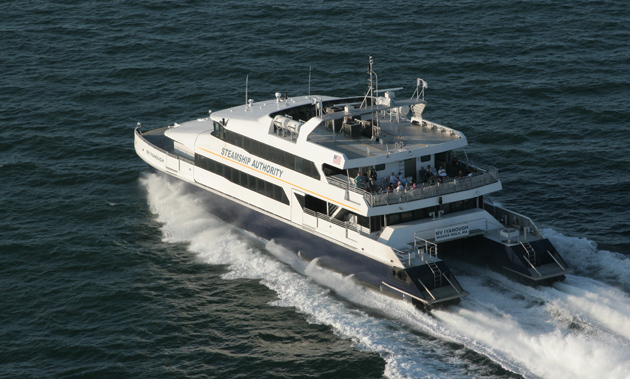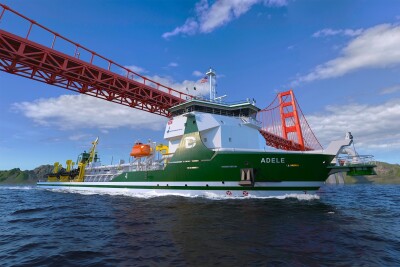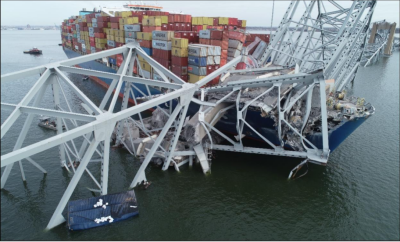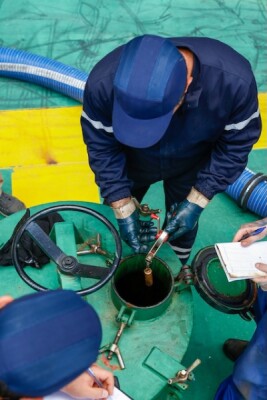The captain of the high-speed catamaran ferry Iyanough may have mistaken a metal pole at the end of a breakwater and two moored sailboats for navigation aids, seconds before the ferry ran hard aground on jetty rocks at Cape Cod, Mass., on June 16.
A preliminary report released by Wayne Lamson, general manager of the Woods Hole, Martha’s Vineyard and Nantucket Steamship Authority says 8’ waves near the channel entrance to Hyannisport harbor may have been a factor too, by obscuring a clear radar image of the jetty. The 154’x39’x5’ Iyanough was inbound from Nantucket island with 48 passengers, six crew members and three food service workers when the allision happened around 9:35 p.m.
In a six-hour operation the Coast Guard and Hyannis Fire Department evacuated the passengers and workers by helicopter and boats, including 15 injured who were treated at a local hospital and released.
According to an account given by Lamson at the Steamship Authority board meeting Tuesday, the Iyanough had departed Nantucket at 8:45 p.m. for its usual one-hour run, with south-southeast winds 30 to 35 mph and intermittent rain and fog.
In the approach to Hyannisport, the captain logged a navigation buoy about 2,500 yards south of the main channel entrance, and asked the pilot to use the searchlight to illuminate the first of three buoys marking the 240’ wide channel. On its way in the Iyanough would have been doing its usual service seed of more than 32 knots.

A FLIR camera image from a Coast Guard helicopter shows the ferry Iyanough hard aground atop the breakwater jetty at Hyannisport, Mass. Coast Guard photo.
Looking at the radar, the captain “recognized the familiar pattern of buoys 4, 5 and 6 and began adjusting the vessel’s course to accommodate its entrance into the main Hyannis channel,” Lamson said in his report. “The pilot was unable to locate any navigational aids with the searchlight.
“But what the captain had interpreted on the radar as buoy No. 4 was in fact the metal pole at the end of the breakwater, which is about 800 yards north of buoy No. 4 and also north of the channel entrance.”
The breakwater itself was not showing on radar because of wave heights, while the pole was still visible, Lamson said.
“In addition, what the captain had interpreted as buoys 5 and 6 were actually sailboats located on the other side of the jetty. The distances and positions of the pole and the sailboats matched identically to the pattern normally associated with buoys 4, 5 and 6.”
After adjusting course to what h thought would be the channel entrance, the captain saw the breakwater and threw the throttles into the “panic stop” mode as he was trained to do, Lamson said.
The Iyanough’s aluminum hull kept watertight integrity and the fuel tanks intact – enabling the ferry to back off with a tow assist around 8 a.m. that morning and get into Hyannisport.
“They were really lucky, it could have been much worse. It basically pushed a pile of rocks out of the way. It’s incredible,” said Peter Duclos, president of Gladding-Hearn Shipbuilding Duclos Corp., Somerset, Mass, which built the Iyanough in 2006. The Incat Crowther design can carry up to 400 people on the 26-mile Nantucket route in about an hour, powered by four MTU 12V 4000 engines, driving a total 9,400 hp through HamiltonJet waterjets for a service speed of 35 knots.
“These boats are built with collision bulkheads and designed to survive flooding of the main compartment,” said Duclos. In the Iyanough allision, crush zones at the bow absorbed the impact before more damage was done.
“Aluminum is pretty amazing. People think it’s flimsy, but it’s really strong,” said Duclos. “It’s very ductile, so it absorbs a lot of energy.”
Gladding-Hearn engineers and fabricators are assisting with repairs to the ferry at Fairhaven, Mass. The vessel could return to service around July 21, and in the meantime the Steamship Authority has leased with Seastreak to make up capacity during it summer peak season.





